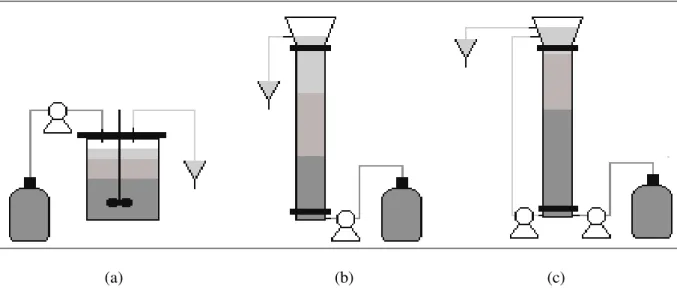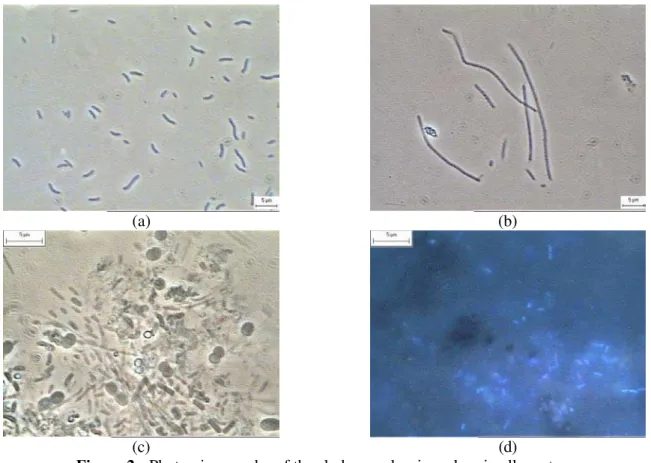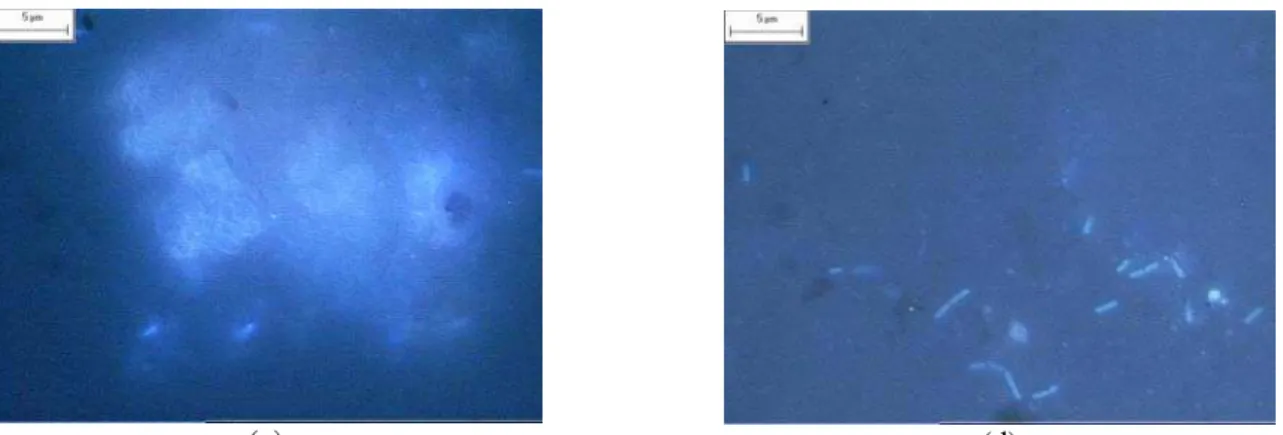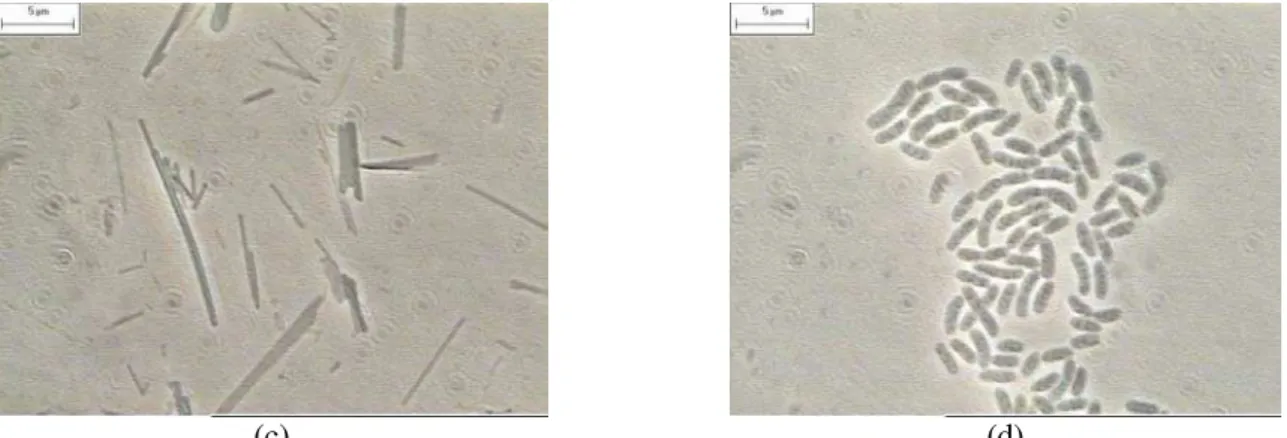ISSN 0104-6632 Printed in Brazil
www.abeq.org.br/bjche
Vol. 22, No. 03, pp. 361 - 369, July - September, 2005
Brazilian Journal
of Chemical
Engineering
A SIMPLIFIED ANALYSIS OF GRANULE
BEHAVIOR IN ASBR AND UASB
REACTORS TREATING LOW-STRENGTH
SYNTHETIC WASTEWATER
R. G. Veronez
1, A. A. Orra
1, R. Ribeiro
2, M. Zaiat
2, S. M. Ratusznei
1and J. A. D. Rodrigues
1*1
Departamento de Engenharia Química e de Alimentos, Escola de Engenharia Mauá, Instituto Mauá de Tecnologia (IMT), Praça Mauá 1, CEP 09.580-900, São Caetano do Sul - SP, Brazil,
E-mail rodrigues@maua.br.
2
Departamento de Hidráulica e Saneamento, Escola de Engenharia de São Carlos, Universidade de São Paulo, USP, Av. Trabalhador São-Carlense 400,
CEP 13.566-590, São Carlos - SP, Brazil.
(Received: December 18, 2003 ; Accepted: November 29, 2004)
Abstract - This work presents an analysis of the changes observed in granule characteristics of sludge in the treatment of synthetic wastewater at a concentration of about 500 mgCOD/L in batch, fed-batch (ASBR) and continuous (UASB) bench-scale reactors under similar experimental conditions. Physical and microbiological properties of the granules were characterized as average particle size and sedimentation time and by optical and epifluorescence microscopy. Several samples were analyzed in order to identify the morphologies. Granules from sequencing batch and fed-batch reactors, either with or without mechanical mixing, did not undergo any physical or microbiological changes. However, during the experiment granules from the UASB reactor agglomerated due to the formation and accumulation of a viscous material, probably of microbial origin, when operated at low superficial velocities (0.072, 0.10 and 0.19 m/h). When the superficial velocity was increased to 8.0-10.0 m/h by means of liquid-phase recirculation, the granules from the UASB reactor underwent flocculation and the microbiological characteristics changed in such a way that the equilibrium of microbial diversity in the inoculum was not maintained. As a result, the only reactor that maintained efficiency and good solids retention during the assays was the ASBR, showing that there is a correlation between maintenance of microbial diversity and operating mode in the case of anaerobic treatment of low-strength wastewaters.
Keywords: Granule features; ASBR; UASB; Low-strength wastewater; Anaerobic treatment.
INTRODUCTION
Up-flow anaerobic sludge blanket (UASB) reactors are certainly the most commonly used anaerobic reactors worldwide, while anaerobic sequencing batch reactors (ASBR) have been pointed to as a potential system for wastewater treatment (Dague et al., 1992; Jeison and Chamy, 1999; Zaiat
al., 1980; Hulshoff-Pol et al., 1983). Anaerobic granular sludge consists of dense multi-species microbial communities. The close association and interaction of anaerobic microorganisms in a granular system permit efficient transport and consumption of intermediate metabolites.
In ASBR reactors the flocculent biomass is gradually converted into highly active granular biomass that settles well due to a selection process during the decanting cycle. The decanting process causes washing out of the poorly settling flocs and disperse organisms, selecting the heavier, better-settling aggregates (Sung and Dague, 1995).
This article aims at evaluating anaerobic granule characteristics in two types of reactors treating a synthetic low-strength wastewater: an ASBR with mechanical mixing and an UASB reactor operated at low and high superficial velocities. The reactors were assayed under similar operating conditions and microscopic observations as well as some physical analyses were used to assess the granule characteristics in both reactors.
MATERIALS AND METHODS
The experimental apparatus (Figure 1) used in this study consisted of two bioreactors: (a) an ASBR with a work volume of 5 L treating 2 L wastewater per cycle (diameter of 18 cm and height of 26 cm, with a liquid height of 20 cm), equipped with a six-vertical-blade disk turbine impeller for mixing, operated in batch and fed-batch sequencing mode; and (b/c) an UASB reactor subject to low and high superficial velocities, respectively, operated in a continuous mode with a work volume of 1.3 L (diameter of 5.3 cm and height of 62 cm – reaction and sedimentation region), equipped without (b) and with (c) an external pump for mixing. The reactors were operated at 30 ± 2 °C. The ASBR was operated with sequential batch cycles of 8 and 6 hours, and the UASB reactor was operated with hydraulic
average particle size diameter of 2.3 ± 0.2 mm and a time required for settling out half of the sludge (θT)
of approximately 10 s.
This concept of settling time has been previously proposed by Hulshoff-Pol et al. (1984) to analyze granular sludge settling characteristics. Initially, 100 mL of sludge was poured into a graduated cylinder. The cylinder was mixed in order to homogenize the sludge and was left to stand. The time required for settling out half of the sludge was measured visually using a chronometer. The assay was done in triplicate.
The synthetic wastewater with a chemical oxygen demand (COD) concentration of approximately 500 mg/L was prepared with sucrose (35 mg/L), starch (114 mg/L), cellulose (34 mg/L), meat extract (208 mg/L), soy oil (51 mg/L), NaCl (250 mg/L), MgCl2.6H2O (7.0 mg/L), CaCl2.2H2O (4.5 mg/L),
NaHCO3 (200 mg/L) and commercial detergent in
order to emulsify the soy oil (3 drops/L). The medium was sterilized (121 °C, 15 min) in order to maintain its characteristics during the time of the experiment.
Concentrations of substrate (measured as COD) in unfiltered and filtered samples, total volatile acids (TVA), bicarbonate alkalinity (BA), total solids (TS), total volatile solids (TVS), total suspended solids (TSS), volatile suspended solids (VSS) and pH were monitored in both the influent and effluent for all conditions, according to the Standard Methods for the Examination of Water and Wastewater (1995).
The microbiological tests of the anaerobic sludge
were done using an Olympus® BX 60-FLA
(a) (b) (c)
Figure 1: Scheme of the reactors: (a) ASBR, (b) UASB and (c) UASB with circulation.
RESULTS AND DISCUSSION
Tables 1 to 3 show a summary of the results obtained in the assays with the ASBR and with the UASB reactor operated at low and high superficial velocities, respectively.
The sludge used in the two reactors in all assays had good sedimentation and microbiological properties, as can be seen by the average granule size (φG = 2.3 ± 0.2 mm), by the time required for settling
out half of the sludge (θT ≅ 10 s) and by the
microbiological population distribution (Figure 2 and Table 4), which showed great morphological variability of bacteria and methanogenic archaea cells, suitable for the experiments developed.
Table 4 and Figure 3 show the microbiological characteristics of the sludge after batch and fed-batch operation, in which the effects of mixing and feed strategy, respectively, were studied (also see Table 1). Analysis of these tables and figures shows that both the granule characteristics (φG = 2.6 ± 0.4 mm
and θT ≅ 10 s) and microbiological diversity were
maintained, despite the different mixing rates (0, 25, 50 and 75 rpm) and feed modes (Rodrigues et al., 2003-a, 2003-b). The granules obtained from the
ASBR had morphologies similar to those
encountered in the sludge used as inoculum, indicating that morphology was maintained, despite the fact that this sludge was obtained from a continuous reactor treating a wastewater different from that used in the current research.
The results obtained in the assays with the UASB reactor, operated at low up-flow velocities (0.072,
0.10 and 0.15 m/h), are shown in Table 2. It should be pointed out that bed movement was considerably reduced, probably due to the low up-flow rate in relation to the apparent sludge density.
Thus, it can be seen that together with a system efficiency which as lower ASBR, than that of the granule characteristics of the sludge, i.e., the average diameter and settling time, were maintained (φG =
2.7 ± 0.5 mm and θT ≅ 30 s). However, generation
and accumulation of a yellowish viscous material, probaby of biological origin, were observed on the surface of the granules. This material caused agglomeration of the granules, thus resulting in a gradual accumulation of biogas and the consequent flotation of the sludge bed with low solids retention, which caused some loss of sludge. This behavior occurred for the three hydraulic detention times applied. It should be pointed out that accumulation of this viscous material started at the top of the sludge blanket, propagating extending the reactor inlet, i.e., towards the bottom of the blanket, probably due to substrate availability (starvation phenomenon).
Neither generation nor accumulation of this viscous material was observed in the ASBR without mechanical mixing and an eight-hour cycle. When the UASB reactor was operated at low up-flow velocities the sludge was not submitted to microbiological analysis at the end of the experiment.
solids retention.
Table 1: Mean values of variables monitored in the ASBR reactor
CET (a)
(mgCOD/L)
CES (a)
(mgCOD/L)
BA (b)
(mgCaCO3/L)
TVA (b)
(mgHAc/L) pH
(b) VSS
(c)
(mg/L) Influent 486 ± 26 – 128 ± 4 35 ± 4 8.8 ± 0.3 22 ± 10 Effluent (6 h-batch assays) 94 ± 9 62 ± 3 222 ± 5 22 ± 2 6.9 ± 0.1 28 ± 14 Effluent (8 h-batch assays) 102 ± 16 71 ± 7 232 ± 7 25 ± 6 6.9 ± 0.1 46 ± 24 Effluent (6-fed-batch assays) 109 ± 14 76 ± 9 230 ± 17 24 ± 3 7.0 ± 0.1 26 ± 11
Number of samples (minimum): (a) 16, (b) 9, (c) 7;
Batch assays: θB = 6 h; VOL = 778 mgCOD/L.d; SOR = 28.3 mgCOD/g-tvs.d; θA = 21 d; mixing rate = 50 rpm; X = 110.7 g-tvs;
Batch assays: θB = 8 h; VOL = 583 mgCOD/L.d; SOR = 20.8 mgCOD/g-tvs.d; θA = 31 d; mixing rate = 0-75 rpm; X = 110.7 g-tvs;
Fed-batch assays: θB = 6 h; VOL = 778 mgCOD/L.d; SOR = 35.9 mgCOD/g-tvs.d; θA = 28 d; mixing rate = 50 rpm; X = 84.0 g-tvs.
Table 2: Mean values of variables monitored in the UASB reactor at low superficial velocities.
CET(a)
(mgCOD/L)
CES(a)
(mgCOD/L)
BA (b)
(mgCaCO3/L)
TVA (b)
(mgHAc/L) pH
(b) VSS
(c)
(mg/L) Influent 485 ± 27 – 126 ± 7 34 ± 4 9.0 ± 0.1 31 ± 16 Effluent (θH = 8 h) 127 ± 21 93 ± 9 215 ± 20 24 ± 4 7.5 ± 0.1 18 ± 8
Effluent (θH = 6 h) 144 ± 18 121 ± 16 195 ± 6 31 ± 5 7.3 ± 0.1 20 ± 13
Effluent (θH = 4 h) 183 ± 24 158 ± 23 184 ± 16 42 ± 8 7.2 ± 0.1 26 ± 13
Number of samples (minimum): (a) 32; (b) 10; (c) 5;
θH = 8 h: VOL = 1.49 gCOD/L.d; SOR = 120 mgCOD/g-tvs.d; θA = 35 d; vS = 0.072 m/h; X = 12.0 g-tvs;
θH = 6 h: VOL = 1.96 gCOD/L.d; SOR = 145 mgCOD/g-tvs.d; θA = 31 d; vS = 0.10 m/h; X = 12.3 g-tvs;
θH = 4 h: VOL = 2.86 gCOD/L.d; SOR = 199 mgCOD/g-tvs.d; θA = 32 d; vS = 0.15 m/h; X = 11.4 g-tvs.
Table 3: Mean values of variables monitored in the UASB reactor at high superficial velocities.
CET(a)
(mgCOD/L)
CES(a)
(mgCOD/L)
BA (b)
(mgCaCO3/L)
TVA (b)
(mgHAc/L) pH
(b) VSS
(c)
(mg/L)
Influent 444 ± 51 – 134 ± 5 26 ± 2 8.9 ± 0.4 75 ± 36 Effluent (θH = 8 h) 119 ± 15 98 ± 16 201 ± 45 16 ± 2 7.0 ± 0.1 19 ± 6
Effluent (θH = 6 h) 143 ± 25 106 ± 10 207 ± 9 16 ± 1 6.9 ± 0.2 35 ± 9
Effluent (θH = 4 h) 181 ± 40 130 ± 25 220 ± 20 23 ± 1 7.7 ± 0.1 32 ± 9 Number of samples (minimum): (a) 18, (b) 16, (c) 7;
θH = 8 h: VOL = 1.33 gCOD/L.d; SOR = 133 mgCOD/g-tvs.d; θA = 28 d; vS = 10.7 m/h; X = 9.5 g-tvs;
θH = 6 h: VOL = 1.78 gCOD/L.d; SOR = 177 mgCOD/g-tvs.d; θA = 30 d; vS = 8.2-1.3 m/h; X = 8.9 g-tvs;
(a) (b)
(c) (d)
Figure 2: Photomicrography of the sludge used as inoculum in all reactors (a – rods; b – Methanosaeta-like; c – cocci; d – cocci and rod-like archaeal cells).
Table 4: Microbiological qualitative analysis of the sludge at the end of the experiment.
Inoculum ASBR UASB* 1 UASB* 2
Rods ++++ ++++ ++++ ++++
Cocci ++ +++ ++++ ++++
Fluorescent cocci ++ ++ +++ +++
Fluorescent rods ++ ++ +++ +++
Vibrium + ++ ++ ++
Methanosarcina-like archaeal cells + ++ – –
Methanosaeta-like archaeal cells +++ ++ + ++
Filaments ++ ++ ++ ++++
Notation: *Reactor with liquid recirculation; 1 – top of the blanket; 2 – bottom of the blanket;
++++ predominant; +++ present in large numbers; ++ present; + rare; – absent.
(c) (d)
Figure 3: Photomicrography of the sludge used in ASBR reactor (a – rods; b – filaments; c – Methanosarcina-like; d – cocci and rod-like archaeal cells).
(a) (b)
(c) (d)
Figure 4: Photomicrography of the sludge at the top of the blanket used in UASB reactor at high superficial velocities (a – filaments; b – rod-like archaeal cells; c – rods; d – cocci).
(c) (d)
Figure 5: Photomicrography of the sludge at the bottom of the blanket used in UASB reactor at high superficial velocities (a, b – Methanosaeta-like; c – filaments; d – rods).
Microbiological analyses performed at the end of each experiment indicate that stratification of the bed reactor based on morphological composition took place. At the bottom of the reactor, bacilli, cocci and filaments as well as fluorescent cocci and bacilli and
Methanosaeta-like archaeal cells predominated, indicating the presence of methanogenic archaeal cells. At the top of the reactor the morphologies were similar to those observed at the bottom, but with fewer
Methanosaeta-like cells and filaments. This may be directly related to the differences observed in the granules. Fang et al. (1994) verified that acetoclastic Methanosaeta were the key structural granules from UASB reactor treating different substrates. Filamentous microorganisms and Methanoseata-like cells seem to have a structural role, producing stability of the pellets formed.
It should be pointed out that changes in the granule characteristics also started at the top of the sludge blanket and extended towards the bottom of the reactor, probably related to substrate availability (starvation phenomenon). In comparative terms, change in granule shape did not take place in the ASBR at a mechanical mixing rate of 75 rpm and an eight-hour cycle, i.e., under similar operating conditions and severe hydrodynamic conditions.
CONCLUSIONS
The results obtained in this work allowed identification of the possible effect of reactor operation mode, continuous or batch, in treating low-strength synthetic wastewater on preservation of granule size and microbiological characteristics. A more stable behavior was observed when substrate became less available, which is characteristic of batch operation (ASBR) and did not occur in the
continuous mode, despite the hydrodynamic conditions of the system.
The granulated sludge underwent little
morphological change in either morphological or physical features (sedimentation time and granule size) during ASBR operation. On the other hand, the sludge was change considerably modified during UASB reactor operation, forming two quite distinct zones with different morphological and physical characteristics.
ACKNOWLEDGMENTS
This study was supported by the Fundação de Amparo à Pesquisa do Estado de São Paulo – FAPESP (São Paulo, Brazil), project numbers 97/05.987-3 and 97/13.270-1 (J.A.D. Rodrigues), 98/10.303-9 (S.M. Ratusznei), 01/00.871-4 (R.G. Veronez), 01/09.331-2 (A.A. Orra.) and 00/12.024-1 (R. Ribeiro).
We gratefully acknowledge Dr. Walter Borzani’s helpful discussions and many valuable suggestions and Dr. Baltus C. Bonse’s revision of this paper.
NOMENCLATURE
Symbols
BA bicarbonate alkalinity, mgCaCO3/L
CES concentration of filtered
substrate in the effluent,
mgCOD/L
CET concentration of unfiltered
substrate in the effluent,
mgCOD/L
CI concentration of unfiltered
substrate in the influent,
mgCOD/L
VT work volume of the reactor
(discontinuous and continuous),
L
VTPC volume treated per cycle
(discontinuous reator),
L/d
X amount of biomass, g-tvs
Greek Symbols
φG diameter of the granules, mm
θA total period of the assay, d
θB batch time, h
θFB fed-batch time, h
θH hydraulic residence time, h
θT time required for settling
out half of the sludge,
min
Abbreviations
ASBR anaerobic sequencing batch reactor
(-)
COD chemical oxygen demand (-)
tvs total volatile solids (-)
ts total solids (-)
UASB up-flow anaerobic sludge blanket
(-)
REFERENCES
Collins, A.G., Theis, T.L., Kilambi, S., He, L. and Pavlostathis, S.G., Anaerobic Treatment of Low-Strength Domestic Wastewater Using an Anaerobic Expanded Bed Reactor. Journal of Environmental Engineering, July, 652-659 (1998).
Dague, R.R., Habben, C.E. and Pidaparti, S.R., Initial Studies on the Anaerobic Sequencing Batch Reactor. Water Science Technology, 26 (9-11), 2429-2432 (1992).
Fang, H.H.P., Chui, H.K. and Li, Y.Y., Microbial Structure and Activity of UASB Granules Treating Different Wastewaters. Water Science
Ecology Proceedings, Washington, pp. 636-642 (1984).
Jeison, D. and Chamy, C., Comparison of the Behavior of Expanded Granular Sludge Bed (EGSB) and Upflow Anaerobic Sludge Blanket (UASB) Reactors in Dilute and Concentrated Wastewater Treatment. Water Science Technology, 8, 91-97 (1999).
Kalyuzhnyi, S.V., Sklyar, V.I., Davlyatshina, M.A., Parshina, S.N., Simankova, M.V., Kostrikina, N.A. and Nozhevnikova, A.N., Organic Removal and Microbiological Features of UASB-Reactor Under Various Organic Loading Rates. Bioresource Technology, 55, 47-54 (1996). Kato, M.T., Field, J.A. and Lettinga, G., The
Anaerobic Treatment of Low Strength Wastewaters in UASB and EGSB Reactors. Water Science Technology, 36, 375-382 (1997). Kato, M.T., Field, J.A., Versteeg, P. and Lettinga,
G., Feasibility of Expanded Granular Sludge Bed Reactors for the Anaerobic Treatment of Low-Strength Soluble Wastewaters. Biotechnology Bioengineering, 44, 469-479 (1984).
Lettinga, G., van Velsen, A.F.M., Hobma, S.W., de Zeeuw, W. and Klapwijk, A., Use of Upflow Sludge Blanket (UASB) Reactor Concept for Biological Wastewater Treatment, Specially for Anaerobic Treatment. Biotechnology Bioengineering, 22, 699-734 (1980).
Liu, Y., Xu, H.-L., Yang, S.-F. and Tay, J.-H., Mechanism and Models for Anaerobic Granulation in Upflow Anaerobic Sludge Blanket Reactor. Water Research, 37, 661-673 (1993). Melo, A.G., Field, J.A. and Lettinga, G., A
Simplified Analysis of Reaction and Mass Transfer in UASB and EGSB Reactor. Environmental Technology, 18, 35-44 (1997). Rodrigues, J.A.D., Ratusznei, S.M., Camargo,
Rodrigues, J.A.D., Ratusznei, S.M. and Zaiat, M., Fed-Batch and Batch Operating Mode Analysis of a Stirred Anaerobic Sequencing Reactor with Self-Immobilized Biomass Treating Low-Strength Wastewater. Journal of Environmental Management, 69, 193-200 (2003-b).
Standard Methods for the Examination of Water and Wastewater, 19th ed, American Public Health Association / American Water Works Association /Water Environment Federation, Washington
D.C., USA (1995).
Sung, S. and Dague, R.R., Laboratory Studies on the Anaerobic Sequencing Batch Reactor. Water Environment Research, 67, 294-301 (1995). Zaiat, M., Rodrigues, J.A.D., Ratusznei, S.M.,




